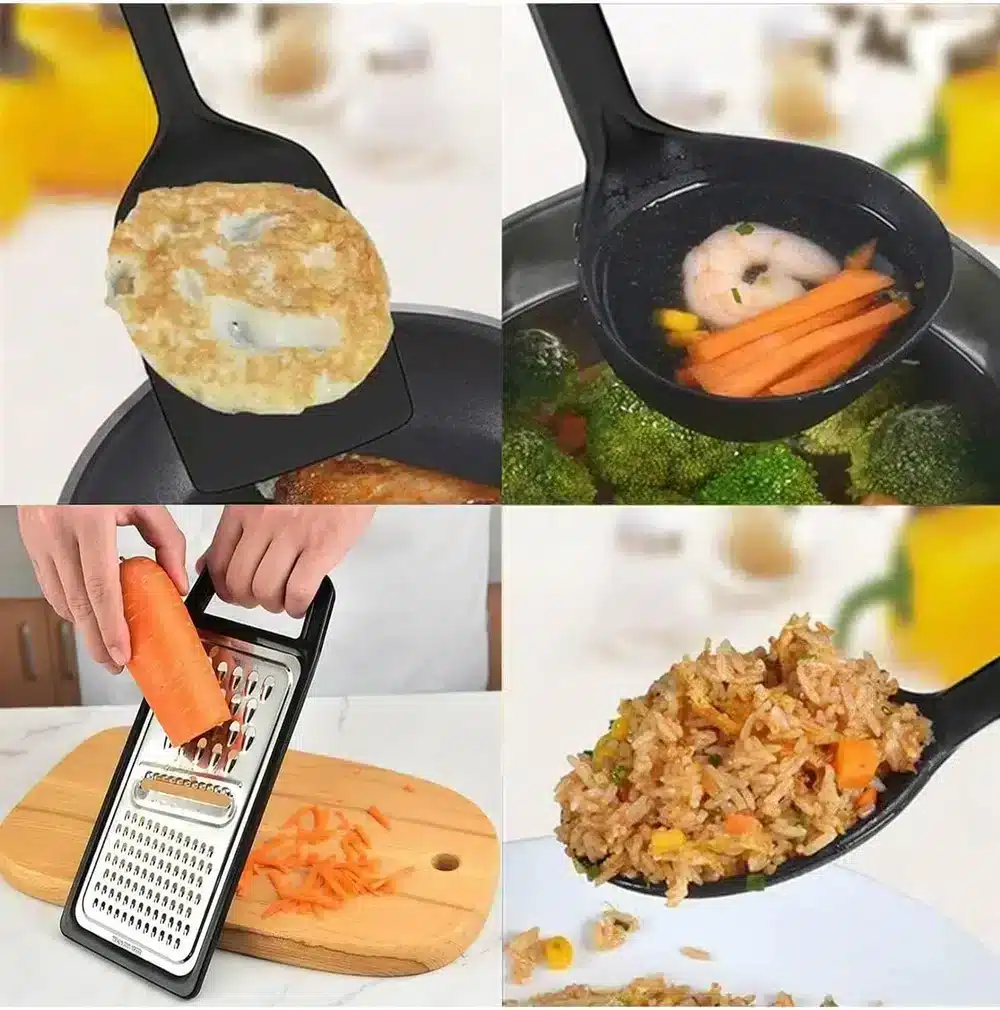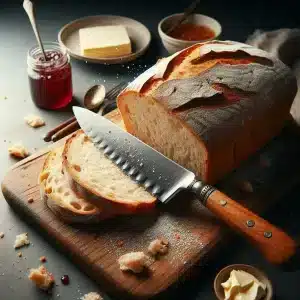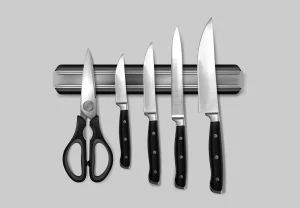Having the most basic utensils is necessary for you to prepare all your favorite dishes. That doesn’t mean you need to have “all” the utensils we are going to name in this list.
That depends entirely on your culinary tastes and what you plan to prepare.
However, we have prepared a guide with some of the most basic kitchen utensils that you will definitely need.
Ready to check out the list?
Let’s get started!
Cookware
Non-stick frying pan
A staple in modern kitchens, the non-stick frying pan is prized for its convenience and practicality. Its key feature is the non-stick coating, which allows for cooking with minimal oil or butter, promoting healthier cooking practices. This coating also ensures that food releases easily from the pan, making both cooking and cleaning hassle-free.
When selecting a non-stick frying pan, consider the pan’s size and depth based on your cooking needs. A smaller pan is ideal for frying eggs or cooking small meals, while a larger one is better suited for cooking larger dishes or for families.
Quality and safety are paramount. Look for pans with durable, high-quality non-stick coatings that don’t chip or peel off easily. Pans free from harmful chemicals like PFOA (Perfluorooctanoic Acid) are a safer choice for your health.
To prolong the life of your non-stick frying pan, use wooden or silicone utensils to avoid scratching the surface. It’s also advisable to cook on low to medium heat, as high temperatures can damage the non-stick coating. Hand washing, instead of using a dishwasher, can further extend the lifespan of the pan.
Saucepan
An essential utensil in any kitchen, a saucepan is designed for tasks like boiling water, cooking grains, and making sauces. Its defining features are high sides and a long handle, making it ideal for both cooking and pouring.
Material is a key factor in selecting a saucepan. Stainless steel saucepans are durable and resistant to corrosion, making them a long-lasting choice. Copper saucepans offer excellent heat conductivity, ensuring even cooking, but they require more maintenance to prevent tarnishing. Anodized aluminum is another popular choice, known for its even heat distribution and resistance to scratching.
Many saucepans come with a lid, which is essential for simmering and boiling. A glass lid is particularly useful as it allows you to monitor your cooking without lifting the lid and releasing heat.
Stock pot
A stock pot is a large, deep pot with straight sides, essential for making stocks, soups, and boiling pasta or vegetables. Its size allows for the preparation of large quantities of food, making it perfect for family meals, meal prepping, or entertaining.
The capacity of a stock pot can range from 6 quarts to 20 quarts or more. Smaller sizes are suitable for everyday household use, while larger sizes are ideal for big gatherings or batch cooking.
Features to consider include a heavy bottom to prevent burning, especially when cooking soups or stocks for a long time. Look for pots with sturdy, heat-resistant handles for safe and easy handling, especially when the pot is full. A tight-fitting lid is important to maintain temperatures and prevent evaporation during long cooking processes.
Sheet pans
These are flat, rectangular metal pans, indispensable in the kitchen for a range of baking and roasting tasks. They’re known for their versatility, used for everything from baking cookies to roasting vegetables and meats.
When it comes to sizes, sheet pans typically come in three standard dimensions: full, half, and quarter size. The half-size pan is most common for home kitchens, fitting most ovens comfortably and providing ample space for most baking needs.
The material of sheet pans can vary. Aluminum pans are popular due to their excellent heat conductivity, ensuring even baking. However, they can warp at high temperatures. Stainless steel pans are more durable and less prone to warping but might not conduct heat as evenly. Non-stick pans are convenient for easy release of food and quick cleanup, but they may require more delicate handling to maintain the coating.
For optimal use, consider lining your sheet pan with parchment paper or a silicone baking mat. This not only makes cleaning easier but also helps to prevent sticking and can extend the life of your pan.
Glass baking dish
Glass baking dishes are a versatile and essential kitchen item, perfect for a variety of baking and roasting tasks. Their transparency is a key advantage, allowing cooks to monitor the progress of their dish without opening the oven.
The material—tempered glass—is favored for its heat resistance and ability to withstand temperature changes. This makes glass dishes ideal for recipes that require baking and then storing in the refrigerator. However, it’s important to avoid sudden temperature changes, such as placing a hot dish on a cold surface, which can cause the glass to shatter.
A notable feature of glass dishes is their non-porous surface, which means they don’t absorb odors or flavors. This makes them excellent for dishes with strong flavors or acidic ingredients.
Utensils
Knives
The cornerstone of any kitchen’s utensil collection, knives are essential for a wide range of food preparation tasks. Selecting the right knife for the job can greatly enhance your cooking efficiency and enjoyment.
The most commonly used types in the kitchen include the chef’s knife, for chopping and slicing; the paring knife, for peeling and trimming; and the serrated knife, ideal for cutting bread and soft fruits. A chef’s knife, typically 8 to 10 inches long, is versatile enough to handle most chopping and slicing tasks.
Wooden spoons
Wooden spoons are a timeless and indispensable tool in the kitchen, favored for their versatility and gentle touch on cooking surfaces. They are ideal for a wide range of tasks, from stirring and mixing to sautéing and serving.
Typically crafted from hardwoods like beech, olive, or bamboo, wooden spoons are durable and long-lasting. These woods are preferred because they don’t easily splinter, are not conductive to heat, and are gentle on non-stick and other sensitive cooking surfaces, preventing scratches.
Wooden spoons come in various shapes and sizes, each suited for specific tasks. A spoon with a broad base is perfect for stirring large pots of soup or stew, while spoons with a more pointed edge are great for getting into the corners of pans. Some wooden spoons feature a flat edge, making them useful for scraping the bottom of pans.
Fish turner
A fish turner is a specialized kitchen utensil designed specifically for handling delicate fish fillets. Its unique design sets it apart from regular spatulas, making it an essential tool for seafood enthusiasts.
The defining feature of a fish turner is its slotted, thin, and angled head, which allows for easy sliding under fish without breaking it apart. The slots also enable excess oil or cooking liquid to drain away as the fish is lifted.
Measuring spoons
Essential for precise culinary creations, measuring spoons are small but vital tools in any kitchen, especially for baking and following recipes accurately. They ensure the correct proportions of ingredients are used, contributing to the success of the dish.
Measuring spoons typically come in a set including standard sizes: 1 tablespoon, 1 teaspoon, 1/2 teaspoon, and 1/4 teaspoon. Some sets also include 1/8 teaspoon and 1/16 teaspoon measures. Each spoon is clearly marked with its size, making it easy to grab the right one.
Tongs
Tongs are a versatile and indispensable tool in the kitchen, used for turning, lifting, and serving food. They provide a firm grip and allow for precise control, making them ideal for a wide range of cooking tasks.
Kitchen tongs typically come in two main types: locking and spring-loaded. Locking tongs can be locked into a closed position for easy storage, while spring-loaded tongs are always ready for use.
They are commonly made of stainless steel, silicone, or a combination of both. Stainless steel tongs offer durability and strength, ideal for heavy-duty tasks. Silicone-tipped tongs are gentle on non-stick surfaces and can withstand high temperatures without melting.
Measuring cups
Measuring cups are fundamental for accurate ingredient measurements in cooking and baking. They ensure consistency in recipes, which is especially crucial in baking where precision is key.
There are two primary types of measuring cups: one for dry ingredients and one for liquids. Dry measuring cups come in sets with standard sizes of 1 cup, 1/2 cup, 1/3 cup, and 1/4 cup. They are designed to be filled to the top and leveled off. Liquid measuring cups are usually glass or plastic with measurements marked on the side. They have a spout for pouring and are read at eye level for accuracy.
Peeler
A peeler is a small, handy kitchen utensil designed primarily for removing the skin from fruits and vegetables. Its simplicity belies its importance, as it makes prep work quicker, safer, and more efficient compared to using a knife.
There are two main types of peelers – the straight peeler and the Y-peeler. The straight peeler, resembling a razor, is held with a handle and the blade is parallel to the handle. The Y-peeler, shaped like a Y, has a blade perpendicular to its handle and is often considered more ergonomic and easier to maneuver.
Most peelers have stainless steel blades, which are durable, rust-resistant, and maintain sharpness. Some models feature ceramic blades, which are incredibly sharp and don’t corrode, but can be more fragile.
Dishes, tools, and gadgets
Cutting board
A cutting board is an essential tool in the kitchen, providing a stable and safe surface for food preparation. Its primary function is to protect your countertops and knife edges from damage during cutting, chopping, and slicing tasks.
Cutting boards come in a variety of materials, each with its own advantages.
- Wooden boards, often made from bamboo, maple, or walnut, are durable and gentle on knives.
- Plastic boards are lightweight, affordable, and often dishwasher safe, making them easy to clean and maintain.
- There are also glass and stone boards, but they can be harsh on knives and are generally used more for serving and presentation.
Salad spinner
A salad spinner is an essential kitchen tool for anyone who enjoys fresh, crisp salads. Its primary function is to clean and dry leafy greens and other salad ingredients, ensuring your salads are free of excess water which can dilute dressings and make the salad soggy.
The device consists of a colander or basket inside a larger bowl, topped with a lid that has a spinning mechanism. After washing your greens and placing them in the basket, you secure the lid and operate the spinner, typically using a handle or a push-button mechanism. This action creates a centrifugal force, flinging water off the leaves and into the outer bowl.
Colander
A colander is a practical and essential kitchen tool used primarily for draining foods like pasta, rinsing vegetables, and washing grains. It’s characterized by its bowl-like shape with numerous holes that allow water to drain while holding the food inside.
Prep bowls
Prep bowls, an essential component in an organized kitchen, are used for holding ingredients before they’re added to a dish. Having a range of sizes is crucial, as it allows for the sorting and measuring of various ingredients in advance, streamlining the cooking process.
These bowls come in a variety of materials, including glass, stainless steel, ceramic, and plastic. Glass and stainless steel are popular due to their durability and non-reactive properties. Ceramic bowls often add an aesthetic appeal, while plastic bowls are lightweight and generally inexpensive.
Microplane zester
A microplane zester is an indispensable tool in any kitchen, revered for its precision and versatility. Originating from woodworking tools, it’s specifically designed for finely grating or zesting a variety of ingredients.
While it’s primarily known for zesting citrus fruits like lemons, limes, and oranges without reaching the bitter pith, it’s also perfect for finely grating hard cheeses, spices (such as nutmeg), chocolate, ginger, and garlic. This makes the microplane zester a multi-purpose tool, useful in preparing a wide array of dishes from savory to sweet.





